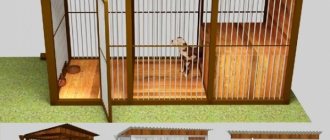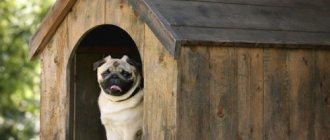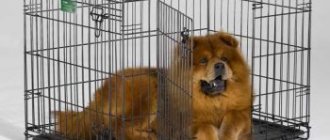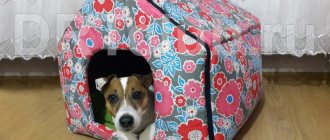Before getting a dog, think about its home and where to place the kennel. Rest in good conditions serves as an excellent mood and a healthy lifestyle for the dog.
It is advisable to choose a dog to guard your dacha or home in the summer or spring, so that the puppy has time to get comfortable and get stronger before the cold weather arrives. From an early age you need to accustom him to street life.
It is much more difficult to train an adult dog to the booth; we will tell you how to do this in another article. Before ordering a kennel, think about where to put the dog house , since you should not change the position. The kennel should be strong and cozy. Choose a kennel based on the size of the puppy, depending on the breed. So that the puppy quickly gets used to his home. Clean the kennel regularly and change the bedding to prevent moisture from accumulating inside the kennel. This will not only improve the dog’s life, but will also prevent the kennel from rotting. For the winter, cover the loophole with thick fabric; tarpaulin, cloth or burlap are perfect for this, or purchase a special nylon curtain for the entrance to the booth
Never force your dog into the kennel. You need to put your dog’s favorite treat in the kennel and she will go for it herself, thereby ending up in the kennel, especially if she has a good appetite. Worsening weather will subconsciously force the dog to seek shelter; in this case, a comfortable kennel will not be left without attention. The dog will choose a kennel that is manufactured and installed correctly. It should be warm and dry. To ensure your friend gets comfortable in his new home as quickly as possible, arrange it carefully. A puppy, like a small child, will be distracted if you put your favorite toys in the kennel. Place a bowl of food next to the booth, the dog will begin to understand that this is its place. Read about how to choose the right bowl for your dog here.
How chain housing affects a dog
Due to the lack of physical activity, the animal’s muscles atrophy over time, paralysis of the limbs occurs, and problems with the cardiovascular system and metabolism begin. The dog becomes wild, irritable, distrustful, and depressed. Loneliness and unfulfilled desires cause her to experience a state of frustration (disappointment), which is manifested by destructive behavior, for example, licking limbs, hunting for her own tail, gnawing on things that have turned up, or incessant barking. It can lead to mental illness. In this case, there can be no talk of friendly relations with the owner.
In some countries (Hungary, Romania, Austria, etc.), keeping dogs on a chain is considered cruelty to animals and is prohibited by law.
Difficulties to be faced
Be patient. A new environment for an animal is always stressful.
At first, the dog may whine loudly and ask to come into the house. In such cases, never ignore your pet - go out and talk to him affectionately. Do not shout or show aggression, because the dog will not understand why he is being scolded - after all, he just wants to get to his beloved owner.
The dog may stop eating. In this case, stop putting pressure on your pet and let him get used to it on his own. Even if it takes a long time, training is not always easy.
An obstinate dog can deliberately ignore the booth, demonstrating character. In this case, you will have to show perseverance. This problem usually occurs with young male dogs. If you cannot manage your training on your own, contact a professional dog trainer for help.
How to keep a chained dog
When putting your dog on a leash to guard your home, follow these tips:
- Accustom your pet to a chain from 6 months. Do this by gradually increasing your “service” time.
- The thickness of the chain links should be selected depending on the weight of the dog: 2 mm - for an animal less than 5 kg, 3 mm - about 10 kg, 4 mm - from 20 kg, etc. (+1 mm for every 10 kg).
- Place a wooden booth on a small pedestal or in a spacious enclosure where the dog will hide from the heat and shelter from bad weather. The walls need to be made double, and between them a thermal insulation material (for example, foam plastic or felt) must be laid, which will have to be changed several times a year. Cover the hole with a curtain made of warm fabric, and insulate the floor with straw or a mattress stuffed with dry grass. The dog must be able to fully fit in the kennel while standing and lying down.
The enclosure should be placed in a dry and sunny place, but with the possibility of shelter from the heat in the booth
- Organize a checkpoint for your pet, thereby expanding the boundaries of its movement. To do this, install poles along the fence and stretch a cable between them with a long metal chain attached to it. It is better to place it at the top, then the chain will not hit the paws, and snowdrifts in winter will not prevent the dog from moving freely. This mobility will help her perform her security function more effectively. Put your dog on a chain only during working hours (at night, if the peak of activity occurs at this time of day), and then release it.
- To prevent your pet from tearing up the beds, flower beds and the ground under the fence, organize a sandbox for him, having previously hidden toys there. When he understands where to dig, reward him with a treat.
- Communicate more with your dog, walk with it every day for 1.5–2 hours, arrange forays into the forest, let it splash out the accumulated energy and get new emotions.
- Train your pet under the supervision of a good dog handler.
- Don't forget to take care of your animal's ears, eyes, teeth and fur. Treat him for parasites and take him for veterinary checkups regularly.
- Provide your four-legged guard with a balanced diet and fresh water. Leftovers from the host's table will not work. Introduce raw meat, cereals, vegetables, as well as vitamin and mineral complexes into your dog’s diet. During the cold season, food should be heated.
- Be sure to castrate the dog, otherwise unmet needs will not allow him to serve effectively.
Street life is not suitable for short-haired and decorative dogs: they will freeze in winter. But representatives of some breeds, with good care and care from the owner, will feel quite comfortable in such conditions, for example, Caucasian Shepherd Dogs, Alabais, Tibetan Mastiffs, etc.
Video: Trainer Paul Owens on how to keep your dog safe in the yard
What not to do
When training a dog to a booth or enclosure, dog breeders should not carry out the following actions:
- Forcing your dog into a kennel, as this will only scare him. It is better to slowly, carefully find out what caused this behavior.
- Overwork, force you to repeat the “place” command. It is advisable to gradually increase the intervals of stay in the booth, and the rest of the time to give the animal freedom.
- Overindulge. Everything needs moderation.
- Punish inside the kennel, force the pet into the enclosure.
[custom_ads_shortcode2]
Owners' opinions
I live in the private sector. Our neighbors have two Caucasians. They have booths, but they move around the territory freely, behave decently and do not bark at everyone. However, one day they forgot to close the gate, and one of the dogs went for a walk outside the site. At that moment I was passing by and experienced extreme stress. Fortunately, the Caucasian was calm as a boa constrictor. He soon returned home, where he felt quite comfortable. My great-aunt also had a chain dog named Bobik. He responsibly guarded the apple orchard, but every evening he ran freely around the yard. Unfortunately, not everyone is so lucky. I remember another neighbor’s dog (short-haired) who spent most of the time just standing at the booth and howling hoarsely in anguish. Towards the end of her life, she lost a lot of weight, and her paws weakened, making them look half-bent. They never let her off the chain, didn’t communicate with her, and didn’t walk her. Local dogs, constantly sitting in enclosures, also suffer from idleness and physical inactivity, so I consider the best option to be the free movement of the animal around the site, the use of a checkpoint at night and the presence of a warm booth in case of bad weather. But the most important thing is the attention and care of the owner.
I have a huge German Shepherd living in my yard. I keep him on a chain, because he has a very intimidating appearance, and if he runs freely around the yard during the day, even passers-by will walk around my yard 200 meters away. That’s why I only let my guard run around at night, when he won’t scare anyone, but the security is excellent. He is happy to run around and I sleep peacefully, knowing that no “night guest” will get into my yard. For a full-fledged lifestyle, the dog should not only rest lying on its side, but also rest actively, that is, run and jump freely.
In my opinion, a chain and an enclosure are the same restriction of freedom. There is a chain that slides freely along a wire stretched over a large area (this is called a block leash), so this is much better than an enclosure, in my opinion. But in any of these cases, the dog needs a walk - to exercise, lose energy, and play. In this case, the temporary restriction will not be a prison. And if it’s chained for life, it’s a nightmare.
Video: the opinion of the owner of a training center about keeping dogs on a chain
A dog sitting on a chain for protection should not be a powerless prisoner. He remains a family member and a pet for whom you are responsible. Provide your dog with competent care, walk, communicate, pay attention, let him off the leash during off-duty hours. Then she will feel needed and responsibly perform the duties of a security guard.
The first time is the most difficult
In order to accustom your dog to a kennel in the yard, you will have to be extremely patient. Even if the pet enters it on its own during the day, and even perhaps spends some time in it, this is not an indication that it will be able and willing to spend the night there.
The first time will be the most difficult. Left alone in the yard, the pet will whine and persistently ask to come into the owner's house. You cannot give in to these plaintive provocations and give in to slack. Once you make concessions and return the animal to the premises, all further attempts to tame it will be reduced to zero.
Additional Information! If an animal squeaks non-stop, you can go out to it, calm it down, pet it, sit with it near the booth, showing by your behavior that it is not alone.
[custom_ads_shortcode3]
Sad dog sat on a chain all his life (8 photos)
This is how our history is being rewritten...New jokes and funny pictures (40 jokes)Unusualities and uniqueness from all over the worldGreat offer from creative people - club administratorNew funny pictures with the inscription (37 jokes)Funny pictures with humor for every dayFunny pictures, funny photos and funny comments (39 photos) A story with a shooting and a chase: a policeman shot a child Reddit users share cool photos of their ancestors A 19-year-old dancer who stopped shaving Cool new life demotivators (43 pieces) Funny pictures, funny comments and funny photos For all the money: “ “networkers” scooped up a mountain of fish from the lake, now they can be planted Humor - jokes and funny pictures (48 jokes) The guy decided to show his prowess, but caused a “domino effect” Cool pictures: humor, irony and positivity Faces of doctors who are at the epicenter of the epidemic Stupidity during a pharmacy robbery, or Three morons are strength! Builders in Moscow found an “echo of the 90s” Cool pictures, comments and photos from the network (45 photos) A girl stole a safe weighing 50 kg and containing three million A manual for Soviet intelligence officers from the 1970s Comedians during their lifetime: what you were like, this way ... Fresh funny pictures with an inscription (39 jokes) The latest funny pictures (49 jokes) Monica Bellucci: photo session February 1, 2022 Demotivators in Russian, new funny ones Funny pictures and funny comments for the mood Demotivators, photo jokes, humor (21 funny) Funny pictures, funny photos and funny comments
What you need to make a swivel
Tools you will need are a drill with a metal drill, a vice, and a sharpening machine. But if you do everything carefully, then you can do without a sharpener altogether.
The swivel itself consists of three elements: an 8-10 mm nut, and two other parts, which are made from nails. Therefore, we will need 2 nuts and 4 nails to make a swivel.
Now regarding the diameter of the metal drill. You need to use a drill such that the nail can pass through the hole freely. In this case, the hole should fit into the side of the nut and even have some margin.
Keeping a dog outside. Ammunition.
There are several ways to keep a dog on the street: free walking on your own territory, an enclosure, a chain or a block, that is, a chain attached to a cable or wire. Most often, a mixed method is used for large guard dogs. For example, during the day the dog is in an enclosure, and at night or in the absence of the owners on a free walk, it guards the house. Or during service, the dog is on a block that covers the territory given to it for protection, and it rests in an enclosure, in a warm booth.
We talked about the dog house earlier. https://kedroffka.ru/soderzhanie-sobaki-na-ulice.html
Let's continue. A CABLE and CHAIN for an Alabai or Caucasian, especially a young and zealous one, must be at least 6 mm thick. If there is a wire instead of a cable, then it is better to pull a double “6” string.
It is better to buy a carabiner that runs along a cable and holds a chain in a special climbing store. What they sell in pet stores and building materials is made in China and will have to be changed every week. You can buy a whole box and check it yourself. But I don’t recommend it, it will end badly.
There are special blocks for connecting the chain and cable, but I can’t tell you where to get such a structure for a huge young and powerful beast.
So, let's tighten the cable. The cable is thick and cannot be tied into knots. To tighten it around a pole, for example, you need to buy a special fastener in the store along with the cable, or rather 2 fasteners for both ends of the cable. Sold at a hardware store. Explain to the store salesperson that you need to put your dog on a block, and a competent salesperson will pick everything up for you.
If you haven’t come across such a seller, move on. We already have a tensioned cable. And a carabiner from climbing equipment. Check in the store that the carabiner fits into the chain link if there is no welded ring at the end of the chain. Next is the chain. It may already be ready especially for the dog. Then it has a ring on one end and a swivel on the other. As a rule, a carabiner is attached to the swivel, which is completely unnecessary for your large dog. It is simply a curved piece of iron without springs or fasteners. It can be used on the farm for other purposes. Or throw it in a trash bin near the store. But there is one plus. The swivel is already attached and welded to this chain. By the way, check all connections so that everything is spinning as needed, and each chain link is welded and not just bent into a ring.
If you can't find a special dog chain, go to a building materials or similar store. There, chains of different thicknesses are sold by the meter. Figure out for yourself how much area you can allocate for moving a dog with a chain, and choose the length from there. Standard chain 3 m. (Never keep a large dog on a 3-meter chain attached at one point without the possibility of running along the cable. He will definitely take revenge on you for this mockery). We chose a chain, 6 mm thick, and the seller cut it for you. We checked that the carabiner for connecting to the cable fits into the link.
If the chain does not have a swivel, after several turns of the dog around its axis, it will all be wrapped up in a large heap. Therefore, we select a strong, large swivel. Again two options. It is better to buy a solid, welded swivel, and attach it to the chain with a simple device called a “chain connector.” It's a thing that looks like a split chain link. After connecting the swivel and the tip of the chain, it needs to be flattened with a hammer and preferably boiled. Or you can use a carabiner, which it is also advisable to fix in a fastened state forever by welding. Anything that can be untwisted, the dog will definitely untwist and run away.
The second option is a prefabricated swivel; it disassembles itself and is inserted into the end of the chain. I remind you again, check that everything fits together right in the store. After assembling such a swivel at the tip of the chain, it also needs to be either welded or riveted so that it never unwinds again.
To attach the dog's collar to the swivel, you need a carabiner. The same Chinese one, teardrop-shaped, in which the side wall is pressed and then fixed with a threaded nut. There is no need to brew this, because every day you will remove the dog from the chain, fasten it on a leash and go for a walk with it. Watch this carabiner carefully so that you can notice a malfunction in time and replace it. Perhaps a carabiner from mountaineering equipment will suit you better here too.
Collar, the last part of a chain dog's equipment. It should, of course, be very reliable: wide, with a double row of holes, with a welded ring, preferably double, double leather or canvas leather. It should sit tightly on the dog, and be able to both tighten it and relax it. This is the part of the ammunition that you need to carefully monitor.
And don’t forget to immediately attach a tag with your phone number to the collar. In case of escape or loss of the dog. Or at least just write it with a marker or pen in large numbers.
To walk your dog, you will need a long tape measure designed specifically for your dog breed. Or a leash of 5-7 meters.
For trips to the veterinarian for vaccinations or treatment, you will need a short leash or carrier and a good muzzle, leather or metal. Modern metal muzzles are very comfortable for the dog; in this they can breathe freely and even drink. And they ensure the safety of surrounding people and animals. Don't forget to train your dog to wear a muzzle.
If you walk in places where there are other people, other animals, a leash is a MUST!, and it is also better to use a muzzle all the time while walking. This will save your nerves and wallet. A child who accidentally falls out of the way of a wolfhound due to a turn will then stutter for the rest of his life, and you will pay for his treatment. The deaf grandmother will not notice you and the dog until the head-on collision, heart attack, and there is no grandmother. A smothered, persistent off-leash Toy Terrier may turn out to be the star of the breed, and you will have to pay for it for a long time.
Don't forget to buy a spare collar, a couple of carabiners and a swivel so that you always have a replacement on hand. On the second collar, be sure to also include your phone number. Reliable ammunition from trusted manufacturers is a guarantee of your peace of mind.
If your dog doesn’t listen to you and it’s difficult for you to walk with it, hurry up to your lessons, learn to drive this fighting machine BEFORE it causes trouble. Dog trainers work in all cities, regions, and even at home. A dog must have its own veterinarian and its own teacher. You won’t sit at the controls of an airplane without knowing how to do it. A wolfhound in your inexperienced hands is a terrible military weapon. Remember this!
It is worth saying that keeping them on a leash is only suitable for guard dogs. Hunting dogs or companions should not be kept this way. This can lead to the development of stress and neuroses. Essentially, a leash is a restriction of a dog’s movement within a certain FENCED area. There is no need to chain your dog in an unfenced area without a fence or gate - this can make it a target for all passers-by, both people and dogs. Near a person, especially outside the city, there are always large or small packs of pariah dogs that have certain spheres of influence in certain territories. Such dogs will not tolerate encroachments on their property; they will defend their territory with all their might. In addition, wild dogs are carriers of various diseases and parasites. Therefore, before placing a dog under guard, you must first fence off your suburban area. This way the dog will know the boundaries of the territory that it needs to protect.
The main and first condition for keeping a dog on the street is the mandatory installation of a fence.
Teaching the command “Place!”
Training your dog to learn this command is quite easy. You need to put a treat in the booth and invite the animal to get it, while saying the word “Place” loudly. After repeating the manipulation several times in a row, take a short break. After some time, the fun game is repeated again, but the treat is placed in the booth every other time.
Additional Information! When teaching a command, you need to choose the right moment when the animal is in a playful mood, it is cheerful and active.
It is quite difficult to train a pet to stay in a kennel. This is a labor-intensive process that requires a lot of effort and patience. To achieve success, you need to act persistently but gently. Through joint games and treats, the owner can show that the booth is very good, comfortable and cozy.
Rate the material 5.0 out of 5 based on 4 votes
It often happens that owners leave their home walls of the apartment and move to a private house. And here a logical question arises: how to train a dog to be in a kennel. After all, the pet is used to living in all its glory, on the sofa or on the armchair.
The easiest way is to accustom a puppy to its new home, that is, to a kennel after an apartment.
It will be more difficult to re-educate an adult dog. But this is also a feasible task. So, what does the owner need to know to re-educate the pet and develop the habit of living in an enclosure or kennel?
[custom_ads_shortcode2]
Keeping a dog on a leash
Quite often, dogs are put on a chain so that they can protect the house and area from uninvited guests without interfering with free movement around the rest of the area. This method is not only the least convenient method of protection, but also does not meet the needs of the dog. With such a content, the animal’s mobility is quite limited; the dog literally lives “on the aisle.” People scurry past it, including strangers, since very rarely the leash is made in such a way as to completely block the entrance. In this case, the dog performs more of a signaling function than a guard, barking to notify about the appearance of strangers.
Being in constant tension, when there is very little time for rest or it is limited to the dark (and it is at this time that the dog is most anxious and prone to activity), contributes to the development of undesirable consequences. The dog becomes embittered, uncommunicative, easily excitable, and barks more out of habit than for a reason. Not in order to attract the attention of the owners to the danger, but simply out of boredom and in order to give vent to irritation. Animals that are initially easily excitable, especially those caught in a chain at a young age, become such “empty-faced” animals. The animal is in a state of constant chronic emotional stress, experiencing a strong hunger for information, since the volume of new (namely new) information received through various senses is limited.
Limited mobility also negatively affects the dog: it is deprived of the opportunity to run, there is only room for short runs or even for walking. The dog is lying idle, it does not develop normal muscles, and a disorder of the musculoskeletal system develops. Poor placement of the harness directly contributes to this. Pet owners mistakenly attach the chain at ground level - this is how it works. With this fastening, and with sudden lunges of the dog, the chain hits the animal’s legs. Chain dogs can be recognized by the characteristic curvature of the hind limbs and by their tied gait.
If there is no other way of keeping it except on a chain, then a more favorable solution can be found. First of all, we will ensure the safety of others - the harness can only be metal. No matter how convenient and attractive modern and popular cables made of polymer materials are today, they have one significant drawback - sooner or later they are all chewed by dogs. In addition, the metal cable often gets twisted, interfering with the dog’s relaxed movements. Very often such cables become frayed and injure dogs. Therefore, the most convenient harness was and remains a chain, of course, provided that it is welded or riveted with high quality.
You also need to remember about the length of the chain and its safe fastening for the animal. If the chain's attachment point is at the height of your pet's withers, it will not cripple the animal's legs. Some fasten the chain with a metal bracket to the wall of the house; at first glance, this seems to be a solid structure, but nevertheless, due to a sharp jerk, the animal can tear out even a very carefully driven bracket. And dogs have enough strength. I happened to see such pictures several times. A dog weighing about two tons is tied to a machine whose body weight is about 50 kilograms. She rushes at strangers approaching the car and pulls this colossus to the side a good meter. So why shouldn’t she rip some kind of bracket out of the wall?!
More reliable solutions for fastening the chain are: riveting the chain to the continuous frame of the booth or passing a special metal stand through the hole. In the first case, the booth must be solid and firmly attached to the base, in the second, the stand must be driven into the ground a third of its height so that the dog cannot tear it out.
For rural residents, keeping a guard dog on a leash on the street is often the only possible option for protecting their home and property. After all, being in a room or enclosure, the dog will not be able to protect the territory from uninvited guests. However, animal owners should remember that when placing a pet on a chain, it is necessary to create all conditions for its comfort and safety.
Why doesn't a dog want to live in a kennel?
A pet may not want to sleep or live in a kennel for various reasons, but all of them can be easily eliminated.
- The animal may not like the smell of the home or some object inside. It is enough to get rid of the unpleasant aroma or something that irritates the dog, and the problem will be solved.
- If the booth is not new (another pet previously lived in it), then the animal may be uncomfortable being there.
- When a dog does not come into his kennel even in the rain, the house may be too small for him (paws, head sticking out of the kennel).
- The dog may be lonely, so you should periodically communicate with it, play, and take it for a walk. Then he will understand that we still love him and will not protest.
- If a stray dog was taken into an apartment, and now the owners plan for it to live in a kennel, you should pay more attention to it, as it may think that it has been put out on the street again.
Dogs with short hair are prone to frostbite and have difficulty withstanding cold temperatures.
[custom_ads_shortcode2]
How to leash train a dog
Large guard breeds with well-developed undercoat are best suited for keeping on a chain: German, South Russian and Caucasian shepherd dogs, Alabais, Russian black terriers. It is not recommended to chain hunting dogs and smooth-haired animals: Doberman Pinschers, Boxers, Cane Corsos, Bullmastiffs.
Keeping an adult dog in chains, already accustomed to constant freedom of movement, can cause psychological trauma in the animal, increased aggression and anger towards the owner. Therefore, you should accustom your four-legged friend to a leash from 4–6 months.
By this time, your pet should be comfortable with the collar, be able to walk on a leash and know the basic commands: “Stay”, “Come to me”, “Next”, “Sit”, “Place”, “No (Ugh)”.
Before chaining your puppy for the first time, let him get used to the kennel and surrounding area. Inside the booth, place the dog’s usual bedding and his favorite toys. You can start tying up your dog only after it has become completely comfortable in its new place.
The puppy’s freedom should be limited gradually, initially by setting up two or three “chain hours” a day.
At first, be prepared for the fact that the baby will constantly whine, bark and want to be free. The main thing here is not to show pity and not to follow your pet’s lead. And so that your four-legged friend does not feel abandoned, approach him more often, talk, play and reward him with treats.
Training methods
It is not easy to train an adult dog to stay in a kennel. If she won't go to the kennel, the following tips will help solve the problem.
- The animal needs to be allowed to get used to it, allowed to enter a new booth, sniff the surrounding area, and wait until it gets used to the enclosure. To do this, you should gradually leave the house with him in dry, warm weather and introduce him to his future home.
- When a dog enters a new home, it is important to reward it with a treat to develop pleasant associations.
- It is worth putting several of your favorite dog toys in the kennel so that the animal can feel a familiar smell.
- When the dog is in the kennel, it is important not to forget about it and not leave it alone. A simple game and communication will reinforce positive emotions.
- It is better to accustom an animal to a new place in warm weather, since in winter being outside can become stressful for him.
The kennel or enclosure is placed facing the front door so that the owner, if necessary, can quickly assess the dog’s condition.
[custom_ads_shortcode3]
Arrangement of the kennel
Keeping a dog on a chain requires the presence of a kennel. It is best to place it in a dry place with a good view of the area.
Install the building on the sunny side, but make sure that the dog has the opportunity to hide in the shade.
The size of the dog's home depends on the size of the animal. Your pet should be free and comfortable in its shelter.
The kennel is made of dry hardwood and placed on a low pedestal. To keep the structure warm, it is equipped with double walls, between which foam or felt is placed.
To avoid the appearance of parasites, thermal insulation materials are changed once a year. To simplify cleaning, it is advisable to equip the booth with a removable roof. The bottom is covered with straw or covered with a mattress stuffed with dry grass or feathers.
The kennel should be cleaned at least twice a week, clearing the space of food debris, excrement, and removing dirt and cobwebs from the walls. It would also be useful to disinfect dogs’ homes monthly with a creolin solution, Deltsid and Bars Forte preparations.
Booth location
The booth must not only be well insulated and high enough so that water does not flood into it when it rains. It must be positioned correctly on the site. The walls should not allow drafts to pass through. With a comfortable house, the question of how to train a dog to a kennel in the yard will be easier to solve.
The pet's room should be located in such a way that the entire site, outbuildings and house can be clearly seen from it. Attention! The booth should be located away from chicken coops and areas where livestock are kept.
The optimal location is near the fence or close to the wall so that the animal has protection from the wind and direct sunlight.
[custom_ads_shortcode3]
Ammunition requirements
For a chained dog, choose wide multi-layer leather collars equipped with a welded ring and a double row of holes. Make sure that the product does not contain sharp edges and edges, and that the metal parts are made of hypoallergenic strong alloys. Two adult fingers should be placed between the collar and the animal's neck.
Leashed dogs are prohibited from using:
- parfors equipped with spikes;
- nooses and half-nooses made in the form of a sliding loop;
- halti.
As for the chain, it is chosen based on the weight of the pet.
| Dog weight (kg) | Chain thickness (mm) |
| 5–15 | 3 |
| 16–25 | 4 |
| 26–40 | 5 |
| more than 41 | 6 |
The owner’s mistake would be to attach the chain directly to the kennel or a separate pole. In this case, the animal can easily get caught, become entangled in the harness and hang on it, which often leads to suffocation.
The most comfortable option for attaching a chain is a checkpoint, which gives the dog the opportunity to move freely and provides ideal viewing and listening of the protected area.
The structure consists of two pillars dug deep into the ground and reinforced with guy ropes, between which a cable with a diameter of 0.6–1 cm is stretched. A suspension block with a welded strong chain up to 2.5 m long is placed on it. To prevent twisting, the harness is equipped with a swivel.
Important! The area where the checkpoint is located must be cleared of vegetation and objects that interfere with the free movement of the dog.
What not to do
When working to train a pet to live in a kennel, many dog breeders make a number of mistakes that absolutely should not be made:
- Forcibly force the animal to stay in its own separate room. This will cause it to experience severe stress and fear. The owner must behave very carefully and act slowly but persistently, without succumbing to pathetic tricks.
- When saying the command “Place!”, you should not overtire your pet, thinking that he will learn everything in one go.
- The animal should be rewarded for correct behavior with its favorite treats, but it should not be overly pampered.
- It is strictly forbidden to shout, much less physically punish, when the animal is inside the booth. This will cause the room to be associated with the fear of punishment, and it will never want to be there again.
Screaming and physical punishment will not lead to the desired result. When accustoming an animal to a leash, you cannot immediately put it on it. It will take some time to adapt to the site.
[custom_ads_shortcode1]
Signs of anxiety
The owner may suspect something is wrong after certain actions of the dog. Most often, a pet, while staying at home, tries in any way to harm the things around it and gets rowdy. He can chew on the shoes of household members, tear up the sofa, tear up the carpet, and scatter things. At first glance, this seems like a fairly harmless dirty trick, but such behavior often indicates that the dog is uncomfortable being alone.
A dog alone at home can behave calmly while waiting for its owner
In addition, neighbors may notice signs of your pet’s not entirely normal behavior. For example, the owner leaves for work, returning, and hears from a neighbor in the entrance that she is tired of the howling of the dog. You should be concerned if the dog howls, whines, or barks for a long time after the owner leaves, and not just for a couple of minutes. You can also notice this if you leave a surveillance camera and a bug at home.
Note! Such a purchase will not be superfluous if you often have to leave the dog at home, but want to know if everything is okay with it. Such devices are convenient because you can remotely monitor how your dog is doing from a smartphone.
A long sleep after the owner returns home also indicates something is wrong, if nothing like this happened before. Dogs often try to compensate for their stress by taking a long rest. If the dog is completely healthy and was active before he was left alone, then you should worry about his condition.
Eating problems also arise from stress. When a dog could eat a whole bowl, and sometimes asked for more, and then refuses to eat, it may be showing its protest and reluctance to be alone.
What surprise might the owner discover when returning home?
Control your emotions when breaking up
Many inexperienced owners say goodbye to their pet too emotionally when they intend to leave him alone in the enclosure. By this they themselves encourage the pet to be nervous and afraid of this moment. As a result, the prospect of being left alone makes him anxious.
Don't repeat this mistake. When you leave, tell your dog in a calm voice to stay in the enclosure. Do not reassure with words: “Stay here, my dear, I won’t be long and will come soon.” The dog does not understand the content of this phrase, but he perfectly detects the alarming, pitiful notes in your voice. That is why he begins to get nervous and prepare for the test.
When you return, you can not hold back your emotions and show them in full force, especially if you have been away for a long time. Play with your dog, give him a piece of food he likes. Tailed friends quickly get used to this way of life if the owner does not make mistakes and behaves consistently.
Safety in the yard
Monitor your pet's behavior. Perhaps the fence is not high enough and the dog is simply jumping over it.
Carefully inspect the area near the fence. Perhaps there are objects near the fence that help the dog overcome the height of the fence - benches, boxes, chairs and other objects. If they are absent, you will have to make the fence higher. By increasing the height, make the top edge of the fence inclined, making it difficult for the animal to overcome the obstacle.
It happens that dogs dig under the fence and crawl out. To avoid this, wire mesh is dug into the ground. Its ends are directed towards the street, then the animal will not get hurt.
An effective method of protection is a barrier made of large stones laid along the fence. This will make it difficult for your pet to dig and escape from the house.
If your yard fence is made of chain link fence, dig it as deep as possible.
Perhaps there are loopholes in the fence that are sealed to prevent the dog from escaping.
Insulation of buildings
In winter, the enclosure should be insulated so that the dog does not freeze and feels comfortable.
To do this, you need to follow several recommendations:
- insulate the walls of the building with polystyrene foam, felt, penoplex or mineral wool;
- distribute straw or sawdust on the floor;
- sawdust must be hammered into the space between the walls;
- it is necessary to choose odorless insulation - if the enclosure smells different, the husky may refuse to enter it;
- the insulation should be isolated from the dog, because the animal can chew through the material.
Felt is considered the safest insulation material. In addition to high thermal insulation, the natural material will not harm the health of the pet. If felt is not suitable, you can use mineral wool.











